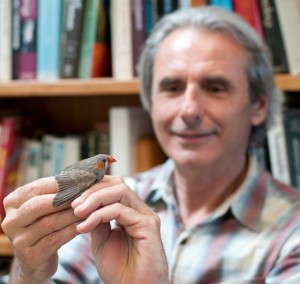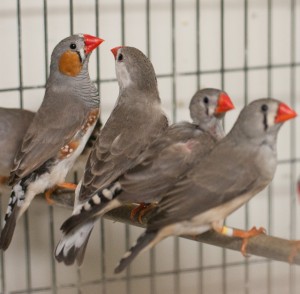5 Questions With . . . John Kirn on Songbird Neuroscience

John Kirn, professor of biology, professor and chair of the neuroscience and behavior program, in May published an article in the Journal of Neuroscience on neurogenesis in songbirds. He recently spoke about his research on WNPR public radio and in The Hartford Courant.
Q: Professor Kirn, you study the neuroscience behind song learning and production in zebra finches. Please tell us about your research, and the surprising findings to come out of your most recent work.
A: I’m interested in the normal functions of adult neurogenesis—the continual addition and replacement of neurons. This happens to a limited extent in humans but is very widespread in the brains of birds. It is a widely held view that this process helps us learn, because young neurons might be more malleable than older ones. In some songbirds, like the canary, the highest numbers of new neurons are added annually when birds are learning new song. But neurons are also added when song does not change.
In the zebra finch too, neuron addition is highest when they are juveniles, learning their song. But song learning is over by adulthood and yet new neurons are still added. Why? We think that neurogenesis may also function to preserve pre-existing knowledge. Our most recent work, though still only correlational, supports this notion. If you deafen an adult zebra finch, song structure breaks down, as is also true with human speech. We recently showed that birds that preserved their songs the longest after deafening also had the highest number of neurons added to a brain region that appears to be critical for the maintenance of song structure.
Q: What are the implications of these findings?
A: They might indicate that adult neurogenesis serves more than one purpose. Depending on the brain region and type of cell produced, perhaps in some cases it promotes the acquisition of new information, while in other cases, it promotes stability of older information.

Q: Why do you study zebra finches, and what can we learn from them?
A: Some of the reasons are simply related to the fact that they seem to be very comfortable in a lab environment. They are highly social and like being in large groups. They also breed throughout the year, providing a continual supply of experimental subjects. The more interesting reasons are that they are vocal learners and need to hear themselves sing in order to learn their songs. In addition, song learning is dependent on social interaction, decreases with age, and relies on a specialized series of brain regions present only in birds that learn their vocalizations. All of these traits are very reminiscent of the case with human language and speech. There is at least one important difference between song and human language, though. To date, there are no examples of songbirds naturally altering the sequence of notes to generate new messages—a hallmark of human language. Nevertheless, zebra finches have provided a wealth of insights regarding both the neural control and nature of vocal sensory-motor learning and even the cultural transmission of behavioral traits.
Q: How might your research apply to human health concerns?
A: My main interest is how the normal brain manages the process of producing new neurons and adding them to pre-existing brain circuits. It is like using your computer while ITS is fiddling with the hardware! Right now, in our own brains, young cells are being formed, and then they must literally climb through a jungle of mature neurons to find the right place to settle in. This amazes me.
My research touches on human health issues only indirectly, but not in a trivial way. The earliest evidence for adult neurogenesis came from work in rodents, but no one believed it because many cell types are produced in adulthood and there were no markers for neurons at the time, so these cells could have been any number of non-neuronal types. The field remained dormant for twenty years, until researchers showed, definitively, that these cells are neurons and that they become functionally incorporated in the brain. This was first shown in birds, and I think this work helped launch the entire field of stem cell research. Determining the identity of adult stem cells was also first shown in birds and then the very same cells were identified in mammals. So I think songbird research can have indirect, but significant influences on research more directly geared toward human health.
The human brain has more in common with the rodent brain than with the avian brain. For example, as already mentioned, neurogenesis is much more widespread in birds than in mice or humans. However, sometimes it might be valuable to study animals whose bodies can do things differently—perhaps better—than ours, with the hope that this information is useful in designing therapies for human brain repair.

Q: What further research do you plan to do in this area?
A: I am very interested in knowing more about the activity patterns of neurons that are added to the adult brain—information that is very limited at present. The zebra finch is a great species for this, because we know that neurons are added to several brain regions that contribute in distinct ways to song learning and production. By looking at the activity patterns of new neurons across brain regions, I’d like to determine whether there are general, shared features among all neuron types produced in adulthood as well as the extent to which activity patterns are specific to the brain region that receives them. The activity patterns of these cells might also reveal the extent to which new neurons are designed for new learning and whether they might also be involved in the preservation of previously acquired song memories.

